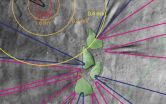(Press-News.org) Pasadena, Calif.—The brain—awake and sleeping—is awash in electrical activity, and not just from the individual pings of single neurons communicating with each other. In fact, the brain is enveloped in countless overlapping electric fields, generated by the neural circuits of scores of communicating neurons. The fields were once thought to be an "epiphenomenon, a 'bug' of sorts, occurring during neural communication," says neuroscientist Costas Anastassiou, a postdoctoral scholar in biology at the California Institute of Technology (Caltech).
New work by Anastassiou and his colleagues, however, suggests that the fields do much more—and that they may, in fact, represent an additional form of neural communication.
"In other words," says Anastassiou, the lead author of a paper about the work appearing in the journal Nature Neuroscience, "while active neurons give rise to extracellular fields, the same fields feed back to the neurons and alter their behavior," even though the neurons are not physically connected—a phenomenon known as ephaptic coupling. "So far, neural communication has been thought to occur at localized machines, termed synapses. Our work suggests an additional means of neural communication through the extracellular space independent of synapses."
Extracellular electric fields exist throughout the living brain, though they are particularly strong and robustly repetitive in specific brain regions such as the hippocampus, which is involved in memory formation, and the neocortex, the area where long-term memories are held. "The perpetual fluctuations of these extracellular fields are the hallmark of the living and behaving brain in all organisms, and their absence is a strong indicator of a deeply comatose, or even dead, brain," Anastassiou explains.
Previously, neurobiologists assumed that the fields were capable of affecting—and even controlling—neural activity only during severe pathological conditions such as epileptic seizures, which induce very strong fields. Few studies, however, had actually assessed the impact of far weaker—but very common—non-epileptic fields. "The reason is simple," Anastassiou says. "It is very hard to conduct an in vivo experiment in the absence of extracellular fields," to observe what changes when the fields are not around.
To tease out those effects, Anastassiou and his colleagues, including Caltech neuroscientist Christof Koch, the Lois and Victor Troendle Professor of Cognitive and Behavioral Biology and professor of computation and neural systems, focused on strong but slowly oscillating fields, called local field potentials (LFP), that arise from neural circuits composed of just a few rat brain cells. Measuring those fields and their effects required positioning a cluster of tiny electrodes within a volume equivalent to that of a single cell body—and at distances of less than 50 millionths of a meter from one another.
"Because it had been so hard to position that many electrodes within such a small volume of brain tissue, the findings of our research are truly novel," Anastassiou says. Previously, he explains, "nobody had been able to attain this level of spatial and temporal resolution."
An "unexpected and surprising finding was how already very weak extracellular fields can alter neural activity," he says. "For example, we observed that fields as weak as one millivolt per millimeter robustly alter the firing of individual neurons, and increase the so-called "spike-field coherence"—the synchronicity with which neurons fire with relationship to the field."In the mammalian brain, we know that extracellular fields may easily exceed two to three millivolts per millimeter. Our findings suggest that under such conditions, this effect becomes significant."
What does that mean for brain computation? "Neuroscientists have long speculated about this," Anastassiou says. "Increased spike-field coherency may substantially enhance the amount of information transmitted between neurons as well as increase its reliability. Moreover, it has been long known that brain activity patterns related to memory and navigation give rise to a robust LFP and enhanced spike-field coherency. We believe ephaptic coupling does not have one major effect, but instead contributes on many levels during intense brain processing."
Can external electric fields have similar effects on the brain? "This is an interesting question," Anastassiou says. "Indeed, physics dictates that any external field will impact the neural membrane. Importantly, though, the effect of externally imposed fields will also depend on the brain state. One could think of the brain as a distributed computer—not all brain areas show the same level of activation at all times.
"Whether an externally imposed field will impact the brain also depends on which brain area is targeted. During epileptic seizures, pathological fields can be as strong as 100 millivolts per millimeter¬—such fields strongly entrain neural firing and give rise to super-synchronized states." And that, he adds, suggests that electric field activity—even from external fields—in certain brain areas, during specific brain states, may have strong cognitive and behavioral effects.
Ultimately, Anastassiou, Koch, and their colleagues would like to test whether ephaptic coupling affects human cognitive processing, and under which circumstances. "I firmly believe that understanding the origin and functionality of endogenous brain fields will lead to several revelations regarding information processing at the circuit level, which, in my opinion, is the level at which percepts and concepts arise," Anastassiou says. "This, in turn, will lead us to address how biophysics gives rise to cognition in a mechanistic manner—and that, I think, is the holy grail of neuroscience."
INFORMATION:
The work in the paper, "Ephaptic coupling of cortical neurons," published January 16 in the advance online edition of the journal, was supported by the Engineering Physical Sciences Research Council, the Sloan-Swartz Foundation, the Swiss National Science Foundation, EU Synapse, the National Science Foundation, the Mathers Foundation, and the National Research Foundation of Korea.
Written by Kathy Svitil
Contact: Deborah Williams-Hedges
debwms@caltech.edu
(626) 395-3227
Visit the Caltech Media Relations website at http://media.caltech.edu.
Neurobiologists find that weak electrical fields in the brain help neurons fire together
Coordinated behavior occurs whether or not neurons are actually connected via synapses
2011-02-03
ELSE PRESS RELEASES FROM THIS DATE:
Field study of smoggy inversions to end
2011-02-03
SALT LAKE CITY, Feb. 2, 2011 – During the past two months, researchers launched weather balloons, drove instrument-laden cars and flew a glider to study winter inversions that often choke Salt Lake City in smog and trap dirty air in other urban basins worldwide.
The field campaign – part of a three-year study by the University of Utah and other institutions – ends Monday, Feb. 7 as atmospheric scientists begin analyzing data they collected to learn how weather conditions contribute to inversions, which occur when warmer air aloft holds cold air ...
Accountable care at Academic Medical Centers: Lessons learned
2011-02-03
Academic Medical Centers (AMCs) must adjust and adapt to the new health care reform laws or risk marginalization in the new health care arena, according to a New England Journal of Medicine Perspective article published online February 2.
The authors of the article, Scott A. Berkowitz, M.D., M.B.A., a fellow in cardiology and geriatrics at the Johns Hopkins University School of Medicine, and Edward D. Miller, M.D., dean and CEO of Johns Hopkins Medicine, argue that AMCs can not only remain relevant in the face of sweeping change, but can lead the way by serving as examples ...
Neiker-Tecnalia creates air-conditioned greenhouse with alternative energies
2011-02-03
Neiker-Tecnalia (The Basque Institute for Agricultural Research and Development) has created an air-conditioned greenhouse using alternative energies that enable the reduction of energy costs, improvements in energy efficiency and an increase in crop yields. The novel system has a biomass boiler and thermodynamic solar panels, which reach an optimum temperature for the crop without using fuels derived from petroleum oil or gas.
Neiker-Tecnalia has installed a biomass boiler (using wood and other organic waste as fuel), together with thermodynamic panels, with the goal ...
Older adults often excluded from clinical trials
2011-02-03
Older individuals, who constitute a rapidly growing population in the United States, account for a disproportionate share of health care utilization and cost.
Yet more than half of clinical trials exclude people based on their age or age-related conditions, according to a new study by Robert Wood Johnson Foundation (RWJF) Clinical Scholars® at the University of Michigan.
"These findings are concerning because it means that doctors cannot be confident that clinical trial results apply to their older patients," says Donna Zulman, M.D., the study's lead author and a ...
First new C. difficile drug in a generation superior to existing treatments: Researchers
2011-02-03
Clostridium difficile infection (CDI) is a significant and growing problem in hospitals and other health care facilities, but no new drugs to treat the condition have been developed in several decades. However, a large-scale, phase 3 trial conducted by Canadian and U.S. researchers shows that the new antibiotic Fidaxomicin is superior to existing treatments, demonstrating a 45 percent reduction in recurrences vs. the existing licensed treatment. Their results were published in February, 2011 in The New England Journal of Medicine.
"There wasn't much interest in C. difficile ...
First evidence for a spherical magnesium-32 nucleus
2011-02-03
Elements heavier than iron come into being only in powerful stellar explosions, supernovae. During nuclear reactions all kinds of short-lived atomic nuclei are formed, including more stable combinations – the so-called magic numbers – predicted by theory. Yet here, too, there are exceptions: the islands of inversion. Headed by physicists from the Excellence Cluster Universe at the Technische Universitaet Muenchen (TUM), an international team of scientists has now taken a closer look at the island that was first discovered. They have now published their results in Physical ...
New nanoparticles make blood clots visible
2011-02-03
For almost two decades, cardiologists have searched for ways to see dangerous blood clots before they cause heart attacks.
Now, researchers at Washington University School of Medicine in St. Louis report that they have designed nanoparticles that find clots and make them visible to a new kind of X-ray technology.
According to Gregory Lanza, MD, PhD, a Washington University cardiologist at Barnes-Jewish Hospital, these nanoparticles will take the guesswork out of deciding whether a person coming to the hospital with chest pain is actually having a heart attack.
"Every ...
UF astronomers, NASA team find 6 closely packed planets orbiting same star
2011-02-03
GAINESVILLE, Fla. — A NASA team including three University of Florida astronomers has found six new planets in a distant solar system that in some ways resembles our own.
The NASA team, including UF associate professor Eric Ford, postdoctoral associate Althea Moorhead and graduate student Robert Morehead, will announce its findings in Thursday's issue of the journal Nature.
"This is the new prototype for a system of rocky planets beyond our own," Ford said. "It changes our understanding of the frequency of solar systems like our own in deep space."
The planets orbit ...
All in the family: Lower back disease may be in your genes
2011-02-03
– Symptomatic lumbar disc disease, a condition caused by degeneration or herniation of the discs of the lower spine, may be inherited, according to a new study published in the Journal of Bone and Joint Surgery (JBJS).
"Previous studies, including studies of twin siblings and subsequent genetic marker studies, have suggested a genetic predisposition for the development of symptomatic lumbar disc disease but have been limited by a small number of patients," noted study author Alpesh A. Patel, MD FACS, assistant professor of orthopaedic surgery at the University of Utah ...
Crowd workers are not online Shakespeares, but Carnegie Mellon research shows they can write
2011-02-03
PITTSBURGH—Writing can be a solitary, intellectual pursuit, but researchers at Carnegie Mellon University have shown that the task of writing an informational article also can be accomplished by dozens of people working independently online.
Each person in the CMU experiments completed just a sliver of the work of preparing an article, such as preparing an outline, gathering facts or assembling facts into simple prose. The "authors" never even spoke with each other. But the research team led by Aniket Kittur, assistant professor in CMU's Human-Computer Interaction Institute ...
LAST 30 PRESS RELEASES:
Climate policies can backfire by eroding “green” values, study finds
Too much screen time too soon? A*STAR study links infant screen exposure to brain changes and teen anxiety
Global psychiatry mourns Professor Dan Stein, visionary who transformed mental health science across Africa and beyond
KIST develops eco-friendly palladium recovery technology to safeguard resource security
Statins significantly reduce mortality risk for adults with diabetes, regardless of cardiovascular risk
Brain immune cells may drive more damage in females than males with Alzheimer’s
Evidence-based recommendations empower clinicians to manage epilepsy in pregnancy
Fungus turns bark beetles’ defenses against them
There are new antivirals being tested for herpesviruses. Scientists now know how they work
CDI scientist, colleagues author review of global burden of fungus Candida auris
How does stroke influence speech comprehension?
B cells transiently unlock their plasticity, risking lymphoma development
Advanced AI dodel predicts spoken language outcomes in deaf children after cochlear implants
Multimodal imaging-based cerebral blood flow prediction model development in simulated microgravity
Accelerated streaming subgraph matching framework is faster, more robust, and scalable
Gestational diabetes rose every year in the US since 2016
OHSU researchers find breast cancer drug boosts leukemia treatment
Fear and medical misinformation regarding risk of progression or recurrence among patients with breast cancer
Glucagonlike peptide-1 receptor agonists and asthma risk in adolescents with obesity
Reviving dormant immunity: Millimeter waves reprogram the immunosuppressive microenvironment to potentiate immunotherapy without obvious side effects
Safety decision-making for autonomous vehicles integrating passenger physiological states by fNIRS
Fires could emit more air pollution than previously estimated
A new way to map how cells choose their fate
Numbers in our sights affect how we perceive space
SIMJ announces global collaborative book project in commemoration of its 75th anniversary
Air pollution exposure and birth weight
Obstructive sleep apnea risk and mental health conditions among older adults
How talking slows eye movements behind the wheel
The Ceramic Society of Japan’s Oxoate Ceramics Research Association launches new international book project
Heart-brain connection: international study reveals the role of the vagus nerve in keeping the heart young
[Press-News.org] Neurobiologists find that weak electrical fields in the brain help neurons fire togetherCoordinated behavior occurs whether or not neurons are actually connected via synapses



